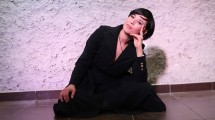Abstract
Martha Graham's work nearly spanned the century, but the decade of the 1930's was of utmost importance both personally and socio-politically. This was the time of the Great Depression in America and Graham's dancing served her country well to artistically move beyond it in the heroic journey of separation, initiation, and return. Her dance was far more than entertainment in relation to the difficult times. In a Jungian theoretical framework, it was compensatory in a powerfully symbolic way. Included here is a brief description of the social climate of the decade and a presentation of C.G. Jung's concepts of symbolic process and compensatory behavior, followed by explorations of three of Graham's dances of that decade “Lamentation,” “Frontier,” and “Every Soul Is a Circus.” She helped the culture move “beyond depression” with these dances. The conclusion is an elaboration of the metaphorical relationship between Graham and her dances and the treatment of clinical depression by dance/movement therapists.
Similar content being viewed by others
References
Armitage, M. (Ed.). (1978). Martha Graham: The early years. New York: DaCapo Press. (Original work published 1937)
Campbell, J. (1967) The hero with a thousand faces. Cleveland and New York: Meridian Books, World Publishing Co. (Original work published 1949)
Eliade, M. (1964) Shamanism: Archaic techniques of ecstasy. (W. R. Trask, trans.) (Bollingen Series LXXVI) Princeton, N.J.: Princeton University Press.
Jung, C. G. (1953). Psychology and Alchemy. (Bollingen Series XX, Vol. 12). Princeton, N.J.: Princeton University Press.
Jung, C. G. (1959). The archetypes and the collective unconscious. (Bollingen Series XX, Vol. 9, Part 1). Princeton, N.J.: Princeton University Press.
Jung, C. G. (1966). The spirit in man, art, and literature. (Bollingen Series XX, Vol. 15). Princeton, N.J.: Princeton University Press.
Jung, C. G. (1966). Two essays on analytical psychology. (Bollingen Series XX, Vol. 7). Princeton, N.J.: Princeton University Press.
Jung, C. G. (1971). Psychological types. (Bollingen Series XX, Vol. 6). Princeton, N.J.: Princeton University Press.
Karasu, T. B. (1990) Toward a clinical model of psychotherapy for depression, I: Systematic comparison of three psychotherapies and II: An integrative and selective treatment approach. American Journal of Psychiatry, 147:2, Feb. 1990, 133–147 and 147:3. Mar. 1990, 269–278.
Leuchtenburg, W. E. (Ed). (1973) The unfinished century, America since 1900. Boston: Little, Brown, and Co.
McDonagh, D. (1973) Martha Graham. New York: Praeger Publishing Co.
Rogers, F. R. (Ed.). (1980) Dance: A basic educational technique. New York: Dance Horizons. (Original work published 1941).
Robertson, N. (1988, October 2). Martha Graham dances with the future. The New York Times, Section 2. p. 1, 26.
Stodelle, E. (1984) Deep Song, The dance story of Martha Graham. New York: Schirmer Books. A Dance Horizons Book.
Weiner, M. and White, M. (1982) Depression as the search for the lost self. Psychotherapy: Theory, Research, and Practice. (Winter) 19, (4), 491–499.
Whitman, W. (1937) Bread and circuses, A study of federal theater. New York: Oxford University Press.
Whitmont, E. C. (1978, paperback). The symbolic quest: Basic concepts of analytical psychology. Princeton, N.J.: Princeton University Press. (hard cover, 1969)
Additional information
In memory, MARTHA GRAHAM, 1894–1991, with gratitude and respect for the dancer, choreographer, healer and woman that Martha Graham was. May we, as dance/movement therapists, continue that which she so boldly began, and may we do this with fierce commitment to the power which movement has to express the truest self.
Rights and permissions
About this article
Cite this article
Welsh, D.J. Martha Graham: The other side of depression. Am J Dance Ther 13, 117–130 (1991). https://doi.org/10.1007/BF00844141
Issue Date:
DOI: https://doi.org/10.1007/BF00844141




